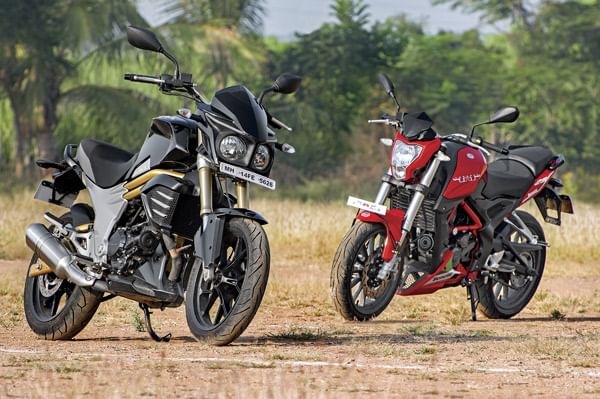Some years ago, premium commuter bikes in India were the 150s. With time though, rising performance bars and aspirations mean engine capacity has had to steadily creep higher to meet the market. And today, premium commuter bike space stretches even up to a 250. We’ve brought together here, two latest newcomers, Mahindra’s Mojo and the Benelli TNT 25. Both Mahindra and Benelli bikes claim to offer just what users are looking for, striving to put their best foot forward. Can either outdo the other? Let’s see.
The Mojo and TNT 25 are pretty distinctive looking bikes. The Mahindra Mojo has more flowing, curvy lines, while the Benelli sports more aggressive, sporty lines. The Mojo headlamp is rounder, with a neat design touch being ‘eyebrows’, almost resembling a face. On the other hand, the TNT 25 has a more muscular headlamp. The fuel-tanks on the two follow diverse themes too, beneath which an exposed chassis conveys this same story.

The Mojo comes with love-em, or-hate-em tubular ‘ribs’ beneath its tank. Overall, the Mahindra bike look muscular, with styling feeling a shade too front-heavy, as too much mass is concentrated forward. The Benelli TNT 25 on the contrary is a compact, more balanced looking motorcycle. The trellis frame exposed below the TNT 25 tank looks nice, and the tail doesn’t look like it ended abruptly, as does the rear of the Mahindra.
What you have to like on the Mojo, is the new engine. The Mahindra has a 295cc, liquid-cooled, four-stroke powerplant, capable of 26.8bhp. However, it isn’t only the figures that please, but the manner in which the new engine delivers refined performance. The engine is smoother than its Benelli rival, with only the slightest vibes at the top-end, accompanied by a nice soundtrack. Mahindra has curiously chosen to give their single-cylinder bike a pair of silencers, which makes little sense, adding weight instead of helping the deserving weight loss cause. A bugbear experienced by us on the Mojo was a tendency for the bike to overheat easily.













































